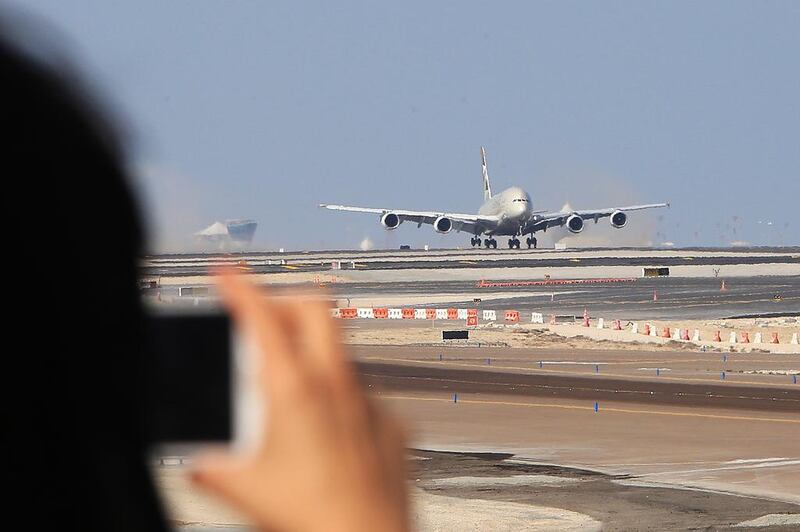Abu Dhabi Airport re-opened its Southern runway yesterday after an Dh830 million renovation to support the arrival of wide-body aircraft and an increase in passengers arrivals.
The refurbishment, which took place between March and December, will allow the Southern runway to accommodate every type of commercial aircraft in the world, including the world's largest, the Airbus A380.
It will also help maintain activity in adverse weather conditions including fog.
The runway features 21 wide-body aircraft stands to accommodate the increase in aircraft movement.
The runway re-opening coincided with the delivery of the first A380 superjumbo aircraft to Etihad Airways.
The Abu Dhabi carrier’s first A380 flight to London Heathrow is planned for this Saturday. Etihad said it will receive a total of 10 A380 aircraft scheduled to arrive over the next few years. The newly opened runway will have the capacity to accommodate 34 flights per hour, which will increase efficiency and reduce air traffic congestion in the UAE’s skies.
"Both runways [Northern and Southern combined] will now handle close to 70 [aircraft] movements per hour, which makes Abu Dhabi airport among the biggest two-runway operators in the world," said Ahmad Al Haddabi, the chief operations officer at Abu Dhabi Airports Company. Annually, the two runways combined will handle 500,000 aircraft movements. Air traffic congestion due to the limited airspace and an increase in the number of flights is causing numerous delays across the Gulf. The problem, if not addressed, can potentially plague the growth of carriers in the region.
By comparison, London’s Gatwick airport has increased its flight capacity to 55 flights per hour or an additional 2 million passengers per year, its technology provider Amadeus said this week. Mr Al Haddabi said that the number of flights movements per hour could eventually be raised at Abu Dhabi.
“There’s a possibility to increase the number of flight movements per hour, the capacity is there and the technology is there. But we are restricted by the regulations of the civil aviation authority,” he said.
Apart from the flight movements, the new runway features a technology that allows aircraft to land in challenging conditions such as in poor visibility caused by thick fog, which is a common problem in Abu Dhabi. Last month, a thick fog settled over the Abu Dhabi Airport and caused 44 early-morning flights to be delayed for at least four hours, along with several cancellations.
“The runway is designed to the latest standards required by the civil aviation regulations, which involves the control of the lighting system and operating the runway with low visibility conditions,” said Mr Al Haddabi.
Along with the Southern runway renovations, the Southern Airfield programme included the construction of a road tunnel underneath the Southern runway.
The tunnel is 1.2 kilometres in length and is 40 metres wide, and will enable passenger and cargo connectivity between the new Midfield Terminal and the existing Terminals 1 and 3.
Abu Dhabi Airports Company is currently constructing the Midfield Terminal Building, which is set to open in 2017. The extension will ultimately increase capacity at the capital's airport to 30 million passengers a year.
Abu Dhabi aspires to be a leader in the aerospace sphere, which falls under its 2030 vision to diversify its economy away from oil.
selgazzar@thenational.ae
Follow The National's Business section on Twitter





